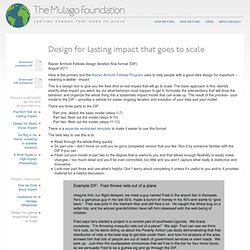

Design for Lasting Impact that Goes to Scale. Rainer Arnhold Fellows design iteration flow format (DIF) August 2011 Here is the primary tool the Rainer Arnhold Fellows Program uses to help people with a good idea design for maximum – meaning scalable - impact.

This is a design tool to give you the best shot at real impact that will go to scale. The basic approach is this: identify exactly what impact you want, lay out what behavior must happen to get it, formulate the interventions that will drive the behavior, and organize the whole thing into a systematic impact model that can scale up. The result of the process– your model in the DIF – provides a vehicle for easier ongoing iteration and evolution of your idea and your model.
There are three parts to the DIF: Part one: sketch the basic model (steps 1-7) Part two: flesh out the model (steps 8-10) Part two: flesh out the model (steps 11-13) There is a separate worksheet template to make it easier to use this format. The best way to use this is to: Part One: the basic model 1. 2. 3. 4. 5. World-Bridger Design » Sweet Tools, Frameworks and Resources for Making Change » World-Bridger Design. Go-go-gadget manic archivist! This list will be updated periodically. Because life goes on. The Twelve Leverage Points for Intervening in a System The Iceberg Model Causal Loop Diagrams Snowden & Boone’s Complexity Framework Co-Design Processes Collective Action Toolkit by Frog Design Just one sample from the toolkit, lots more juice in the full PDF. IDEO Human-Centered Design Toolkit Check it out here . Rapid Prototyping The Business Model Canvas Mind-Mapping Asset Mapping Permaculture Design Patterns Gaiacraft Cards.
Biomimicry Design Spirals via The Biomimicry Institute Gamification – 4 types of fun The Natural Step Herman Daly’s Ends/Means Pyramid Image by Jon Erickson (2005) via Jim Pittman The Quadruple Bottom Line New Economy, New Wealth by Art Brock The Wheel of Diversity. GOOD Maker. OpenIDEO - Home. Mapping Toilets in a Mumbai Slum Yields Unexpected Results. Slide Show In a Mumbai Slum, the Never-Ending Wait for a Toilet Facility It was while stepping over the channels of ochre fluid that run between the raggedly cascading apartment blocks that make up the Mumbai slum known as Cheeta Camp that James Potter discovered a real-life version of what could be a scene out of a magical realist novel by Salman Rushdie: a toilet facility that gets built and then torn down again, always on the verge of being finished, but never usable.
“Five or six people circled around to tell me the tale of the perpetually about-to-open toilet. Apparently, for the last 15 years or so, the toilet had been built, demolished and rebuilt three times,” said Mr. Potter, a Hindi-speaking student who is pursuing his master’s degree in public health at Harvard. Each time, local politicians claimed that the lavatory facility would open “after the elections,” but that never happened. Mr. Mr. Cheeta Camp is an Indian oddity — a planned slum. So toilets were built ad hoc. The MakeSense Blog. HCD Connect.